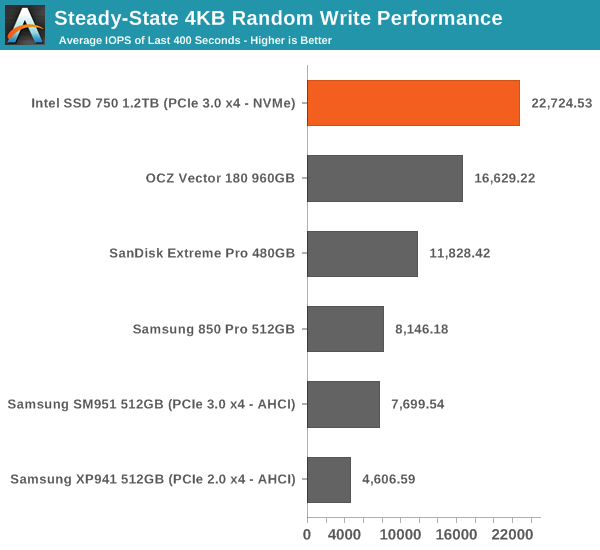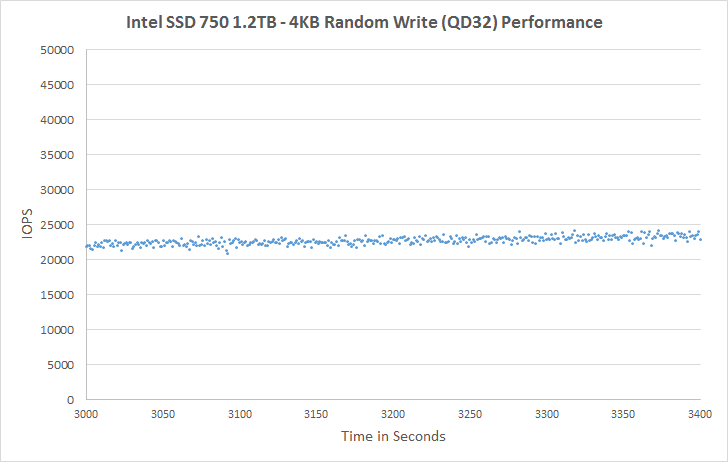Intel SSD 750 PCIe SSD Review: NVMe for the Client
by Kristian Vättö on April 2, 2015 12:00 PM ESTPerformance Consistency
We've been looking at performance consistency since the Intel SSD DC S3700 review in late 2012 and it has become one of the cornerstones of our SSD reviews. Back in the days many SSD vendors were only focusing on high peak performance, which unfortunately came at the cost of sustained performance. In other words, the drives would push high IOPS in certain synthetic scenarios to provide nice marketing numbers, but as soon as you pushed the drive for more than a few minutes you could easily run into hiccups caused by poor performance consistency.
Once we started exploring IO consistency, nearly all SSD manufacturers made a move to improve consistency and for the 2015 suite, I haven't made any significant changes to the methodology we use to test IO consistency. The biggest change is the move from VDBench to Iometer 1.1.0 as the benchmarking software and I've also extended the test from 2000 seconds to a full hour to ensure that all drives hit steady-state during the test.
For better readability, I now provide bar graphs with the first one being an average IOPS of the last 400 seconds and the second graph displaying the standard deviation during the same period. Average IOPS provides a quick look into overall performance, but it can easily hide bad consistency, so looking at standard deviation is necessary for a complete look into consistency.
I'm still providing the same scatter graphs too, of course. However, I decided to dump the logarithmic graphs and go linear-only since logarithmic graphs aren't as accurate and can be hard to interpret for those who aren't familiar with them. I provide two graphs: one that includes the whole duration of the test and another that focuses on the last 400 seconds of the test to get a better scope into steady-state performance.

Given the higher over-provisioning and an enterprise-oriented controller, it's no surprise that the SSD 750 has excellent steady-state random write performance.

The consistency is also very good, although the SSD 750 can't beat the 850 Pro if just focusing on consistency. When considering that the SSD 750 provides nearly three times the performance, it's clear that the SSD 750 is better out of the two.
 |
|||||||||
| Default | |||||||||
At the initial cliff the performance drops to around 15K IOPS, but it quickly rises and seems to even out at about 22-23K IOPS. It actually takes nearly an hour for the SSD 750 to reach steady-state, which isn't uncommon for such a large drive but it's still notable.
I couldn't run tests with added over-provisioning because NVMe drives don't support the usual ATA commands that I use to limit the LBA of the drive. There is similar command set for NVMe as well, but I'm still trying to figure out how to use them as there's isn't too much public info about NVMe tools.
 |
|||||||||
| Default | |||||||||










132 Comments
View All Comments
knweiss - Thursday, April 2, 2015 - link
According to Semiaccurate the 400 GB drive has "only" 512 MB DRAM.(Unfortunately, ARK hasn't been updated yet so I can't verify.)
eddieobscurant - Thursday, April 2, 2015 - link
You're right it's probably 512mb for the 400gb model and 1gb for the 1.2tb modelAzunia - Thursday, April 2, 2015 - link
In PCPer's review of this drive, they actually talk about the problems of benchmarking this drive. (https://www.youtube.com/watch?v=ubxgTBqgXV8)Seems like some benchmarks like Iometer cannot actually feed the drive, due to being programmed with a single thread. Have you had similar experiences during benchmarking, or is their logic faulty?
Kristian Vättö - Friday, April 3, 2015 - link
I didn't notice anything that would suggest a problem with Iometer's capability of saturating the drive. In fact, Intel provided us Iometer benchmarking guidelines for the review, although they didn't really differ from what I've been doing for a while now.Azunia - Friday, April 3, 2015 - link
Reread their article and it seems like the only problem is the Iometer's Fileserver IOPS Test, which peaks at around 200.000 IOPS, since you don't use that one thats probably the reason why you saw no problem.Gigaplex - Thursday, April 2, 2015 - link
"so if you were to put two SSD 750s in RAID 0 the only option would be to use software RAID. That in turn will render the volume unbootable"It's incredibly easy to use software RAID in Linux on the boot drives. Not all software RAID implementations are as limiting as Windows.
PubFiction - Friday, April 3, 2015 - link
"For better readability, I now provide bar graphs with the first one being an average IOPS of the last 400 seconds and the second graph displaying the standard deviation during the same period"lol why not just portray standard deviation as error bars like they are supposed to be shown. Kudos for being one of the few sites to recognize this but what a convoluted senseless way of showing them.
Chloiber - Friday, April 3, 2015 - link
I think the practical tests of many other reviews show that the normal consumer has absolutely no benefit (except being able to copy files faster) from such an SSD. We have reached the peak a long time ago. SSDs are not the limiting factor anymore.Still, it's great to see that we finally again major improvements. It was always sad that all SSDs got limited by the interface. This was the case with SATA 2, it's the case with SATA 3.
akdj - Friday, April 3, 2015 - link
Thanks for sharing KristianQuery about the thorough put using these on external Thunderbolt docks and PCIe 'decks' (several new third party drive and GPU enclosires experimenting with the latter ...and adding powerful desktop cards {GPU} etc) ... Would there still be the 'bottle neck' (not that SLI nor Crossfire with the exception of the MacPro and how the two AMDs work together--would be a concern in OS X but Windows motherboards...) if you were to utilize the TBolt headers to the PCIe lane-->CPU? These seem like a better idea than external video cards for what I'm Doing on the rMBPs. The GPUs are quick enough, especially in tandem with the IrisPro and its ability to 'calculate' ;) -- but a 2.4GB twin card RAID external box with a 'one cord' plug hot or cold would be SWEEET,
wyewye - Friday, April 3, 2015 - link
Kristian: test with QD128, moron, its NVM.Anandtech becomes more and more idiotic: poor articles and crappy hosting, you have to real pages multiple times to access anything.
Go look at TSSDreview for a competent review.